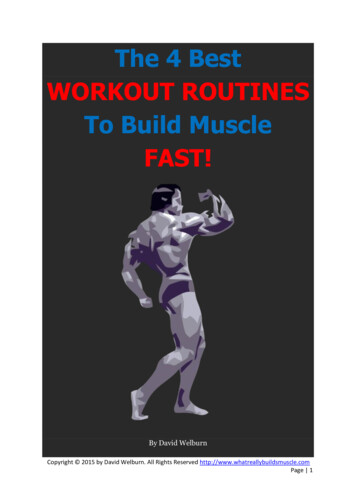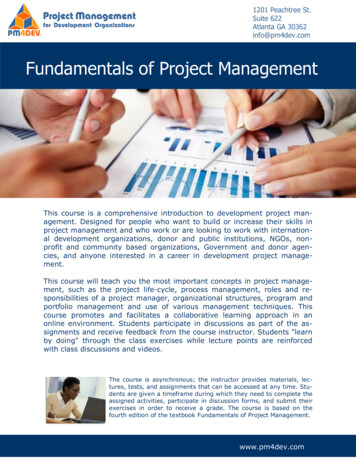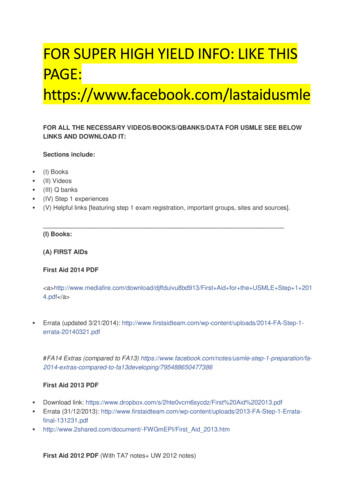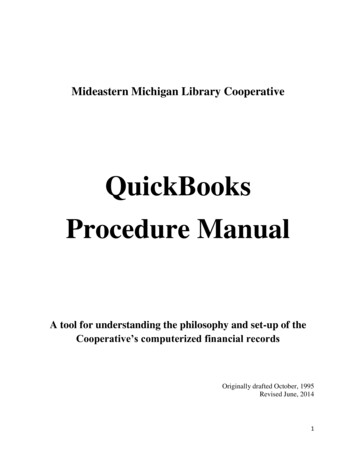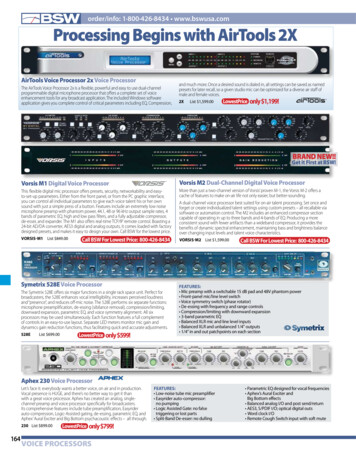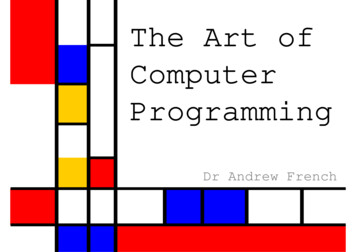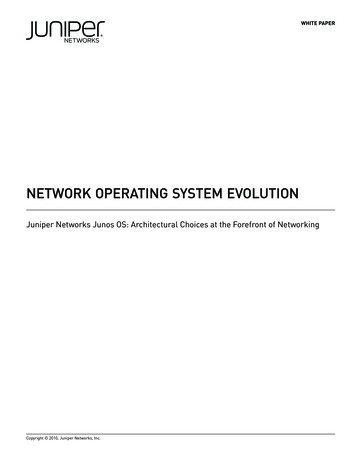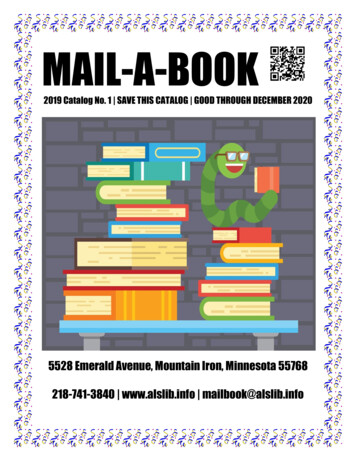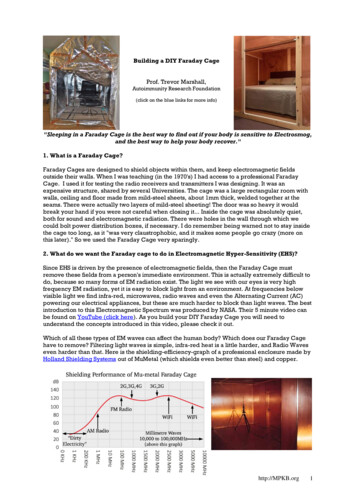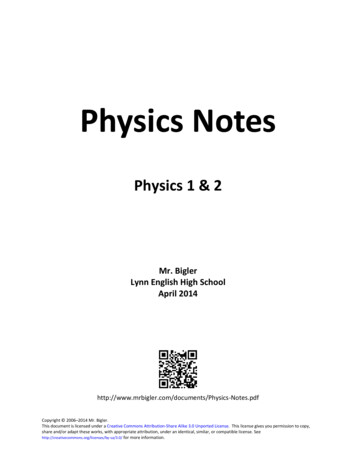
Transcription
ASKEY'S PROCEDURES, ROUTINES , INFOAP Physics C 2011 / 2012Materials REQUIRED for this course:* We will use two hardcover Engineering Grid NotebooksOne notebook is 168 pages and will be used for daily notes. (8.8” x 13.5”)The other is 96 pages and will be used for homework. (8” x 10”)The pair of notebooks cost me 40 (including shipping) ; a 20 donation is MUCH appreciated.* pencils required for exams; pencils or pens for everything else* Calculator that allows you to input trig functions (sin, cos, tan).Note: A programmable calculator is most advantageous since I allow formulae input.RESOURCES:Textbook: Physics for Scientists and Engineers (6th edition, 2004) by Raymond Serway and John JewettThomson, Brooks/Cole PublishersVideo Demonstration Series: Physics Demonstrations in Mechanics Physics Curriculum & InstructionVideo Historical Background: The Mechanical Universe (Annenburg Series) & various books & websitesDVD Demonstration Series: Active Figures from Text & various websitesComputer Programs Used for Animations: Force and Motion by Fable Multimedia & various websites1. DISTRIBUTION OF GRADES AND GRADING SCALE:Each chapter’s homework and notes are40% of the chapter grade and the test is the other 60%GRADING SCALE: 89.5-100% A 79.5-89.4% B 69.5-79.4% C 59.5-69.4% D 0-59.4% FOver the last 10 years, 95% of my AP Physics students pass and 85% get an A or a B.2. MY TEACHING METHOD FOR THIS COURSE:AP Physics C is very fast paced and calculus intensive. You need to be very comfortable with Algebra 1 and 2,Geometry, Math Analysis, and should either have already completed a calculus course or concurrently beenrolled in one. I consider the best approach to teaching to get the student as involved in the concept aspossible. My first approach will always be to have small groups work with observables to develop therelationships themselves with only as much guidance as necessary from me. If the materials are not available orwe are under time constraints, I will demonstrate the relationships between objects while asking the class a lotof questions. If that is not an option, we will discuss the new relationships as a class. I will limit lecturing to youas much as possible, but we are very tight time constraints in order to prepare you for the national AP Physicstest in May. We will derive almost every formula we encounter so you understand the roots of thesefoundational mechanical physical relationships that you will use the rest of your science career. As the courseprogresses, you will begin to appreciate the underlying mathematical formulas that govern the world anduniverse around you. Last year’s physics course was a good introduction for you, but it is THIS year that we getmuch much more real.
3. NOTEBOOKS: Class notes, informal and formal laboratory write ups, and homework will be kept in yourhard cover engineering notebooks. I will check your notebooks in class regularly. I will check for homeworkcompletion and adequate class notes and any laboratory write ups in that proceeding period. Late notebookswill be deducted 10% for every school day that it is late. Use the following methods to organize yournotebooks.CLASS NOTES NOTEBOOK:You will be given an outline of each chapter complete with figures, tables, reference material, discussionquestions and sample problems. We will tape these into your notebooks and use them as an organizer during ourclass discussions.CHAPTER HOMEWORK NOTEBOOK:1.) I will provide a copy of the chapter and supplemental problems. You will cut these up and tape them intoyour homework notebook where you will show all your work on each problem.2.) Clearly indicate which set of work goes with which problem. If I have to waste time looking all over thepage to determine which set of work goes with each problem, I will have to take off some “chaos points”3.) Show all your major steps in solving the problems. This includes drawing and labeling sketches.4.) All work and answers on problems must be hand written in pencil (preferably) or pen.5.) All numbers shown in the opening equation of each major step in the solving of theproblem must have units. Of course, the answer must have units. (m/s, g, N, s, Hz, etc.)6.) Box in your answersFOR FORMAL LABORATORY WRITE UPS:You will do informal labs in your lab groups and observe demonstrations. Some of the laboratories we performwill be considered formal. All formal labs need to be written up using the format below. No piece of scientificwork can be considered as finished until the experiment is described and the results and pertinent thoughts ofthe student are recorded on paper in such a way as to be intelligible to qualified people. At least as much effortis required in this phase of an experiment as is necessary in its planning and execution. It is not a simple matterto express oneself in a style which is logical, unambiguous, comprehensive, and relevant. To achieve such astyle, you will have to devote quite a bit of persistent effort to the writing, and must develop a critical attitudetoward your own work. The next page has the outline you MUST follow.
NHS AP Physics C Formal Laboratory Write Ups1. Introduction: The reader must be oriented so that he or she may readilyunderstand your presentation. You should accomplish this through an introductorycouple of paragraphs. This introduction forms a link between the reader's broadgeneral knowledge of physics and the specific experiment you are reporting on. Makesure you include a statement of the objectives of the experiment in this section.2. Background Theory: General conceptual information leading the reader up to thereason for the experiment you performed. Any equations leading up to the questionat hand are necessary here. This may include of equations and even derivations ofequations representing the relationships involved in the experiment3. Equipment: Simply list, in as much detail as possible, the equipment you used toperform the experiment. Remember, you are writing this report for an intelligentpeer who has never done the experiment, has no idea how it will turn out, and willbe attempting to try to repeat your procedures to see if they get the same results.So the equipment list has to be specific enough for the reader to go out and buy orround up whatever material they need.4. Procedure: This section, should tell the reader in relevant detail what was done,the procedures, the observations, the precautions, and the conditions of theexperiment. Include in this section as much of the following as possible:* An listing of the procedure steps you followed.* A sketch or diagram of the equipment (very important) showing the setup withmajor pieces of equipment identified.* A discussion of the measurements you performed and your observations inperforming these measurements. Also a short discussion of how you know what theuncertainties on the measurements are.* All of the raw data in table form, clearly labeled including estimates ofexperimental uncertainties.* All formulae used. Try to derive or justify (by reference) the ones you used.5. Results: This section presents the results in such a way that the reader can graspthem quickly and easily. Make sure you include the following if possible:* Analysis of the data, including sample calculations, and final results with anacknowledgement of errors in equipment and human errors.* A graphical representation of results if at all possible (VERY IMPORTANT)6. Conclusions and Applications: What are the conclusions and discussion of theexperiment and its relationship to what we have been studying. Include a list ofreferences used if any.
4. HELP!!!!!!!!!Good grief Mr. Askey, ARE YOU SERIOUS about all that homework and Formal Labs? Man, you’re scaringme! This seems way more intense than Physics was last year!Hey . . . uhhhh . . . this is Engineering Physics, a sophomore level university course. Lots of work comes withthe college credit. Good news . . . There are LOTS of live and internet help available. STRETCH and afterschool is the best time to come in for help. Also . . . no flying solo in here. We use the buddy system. More likea family thing. Lots of homework/study parties!! You will all be very close and dependent on each other by thetime May comes around.5. EXAMS:Since this is a 1st hour class, we may have a little leeway on testing time. We’ll see how many of you are inZero Hour.Check out the Color AP Physics Calendar and you will see the 1st semester schedule.Notice first that all the homeworks are assigned and checked . . . THEN . . . you will be given a fairly longTAKE HOME TEST with a fairly long time to complete it. I will always try to give you and yourstudy group a weekend plus a week night or two to finish this. I fully expect you to work on this with yourstudy group AFTER you have looked it all over and have finished as much as you could on your own. Someonevolunteers (switch off for every test) to cook or order pizza, someone else brings the drinks (milk, OJ, applejuice, etc.) and you all sit down for an evening full of the joy of learning the foundational rules of the universe.The content of the Take Home Test will come mostly from your class notes with an emphasis on Board Workproblems, but the test will also contain four challenging problems very similar to four specially chosenhomework problems. The take home test is worth approximately one third of your Exam score.Now notice on the calendar that there is a RED DAY the week after the Take Home Test is assigned.We will grade and go over the entire test on that day.Now, there should be a day or two between the Red Day and the In Class Test. It depends on wherethose days come on the calendar. Anyway . . . on the IN CLASS TEST, you will have anywherebetween 61 minutes and 90 minutes (depending on your zero hour situation) to completeapproximately half of the Take Home Test problems for approximately two thirds of your totalexam score. There will be a card part and a no card part similar to Physics. No, they won’t be theexact same problems, but they will be close enough that if you really understood the concept andcould handle the problem on the Take Home Test or after Red Day, you’ll get the problem right on theIn Class Test. The In Class Test will also contain problems very similar to two of the four homeworkproblems from the Take Home Test.
6. HOMEWORK:The key to your understanding the foundations of this complex and difficult universe is for each of youindividually finding the time each night to slowly work through the homework problems yourself and not tryingto cram it into one night or one hour or looking off a friends work the night before it’s due or even the nightbefore the in class test. Remember the Red Poster:!!“Your determined attempt to fight through a tough physics problem or questionon your own is the pivotal factor in your eventual true understanding in this class.”I will assign the homework papers containing the sets of problems for each chapter when I pass out the chapterdiscussion questions. You will tape the discussion questions into the chapter notes notebook and the homeworksheets into the homework notebook. See the calendar for the dates that the homework is due. I don’t roll thedice for homework in here. On the day the homework is due I will come to your desk and check yourhomework notebook. I won’t waste precious class time doing this since the homework check will occur whileyou and the rest of the class are working a problem on the board.I will not post a chapter’s homework keys to the my website until the Friday evening on the weekendbefore that Chapter’s RED DAY.7. BOARD WORK: You will be going to the board to work problems together as much as possible in here.Unless there is an In Class Test or a Red Day, you and a partner will tackle these daily challenges head on.There must be accountability. Board work fails when only five or six students understand what they are doingand the other dozen or so “play along”. Board Work is the time that we ALL help each other work throughthose difficult concepts so that by the time you go back to your seats, you have a much better, if not yet, totallycomplete, understanding.Board work is worth 100 points a nine weeks. These are NOT bonus points. Five points will be awarded eachtime you and your partner complete a board problem. You each will sign the board poster once I have checkedand approved your work. Three students per group is too much, you can work on the board on your own, but Istrongly encourage you to work in pairs. I want this class to become a family so I will ask you to mix it up andhave a different partner after every five board works so everyone is involved.I will take a picture of at least one worked out problem to put on the internet as part of our screen shots. Makesure your name is easily readable so that I can tally up and award that pair bonus when I go through the screenshots at the end of the chapter.You WILL still have to write the problem into your notes even though you worked the problem on the board. Ifyou would rather wait until you get home and look off the screen shots, that is okay, but the work must be filledout by the time I check your notebooks while you are taking your In Class Test.8. THE AP PHYSICS C EXAM IN MAY:AP Physics C contains some problems involving the application of elementary calculus. AP Physics C isactually two tests. A “Mechanics” test and a “Electricity and Magnetism” test. You can take one or both. Youreceive two separate grades (based on the usual 1-5 scale). Most universities will give you separate credit foreach. Usually, a mechanics score of 4 or 5 (sometimes a 3, if you can show them a good notebook) will get youout of your 1st semester Engineering Physics course. This is fantastic since this course is usually a “weedingout” course for those students who don’t really belong in engineering. You would skip this semester and go intothe second semester Engineering Physics course which is El
11.09.2011 · DVD Demonstration Series: . foundational mechanical physical relationships that you will use the rest of your science career. As the course progresses, you will begin to appreciate the underlying mathematical formulas that govern the world and universe around you. Last year’s physics course was a good introduction for you, but it is THIS year that we get much much more real. 3. NOTEBOOKS .
